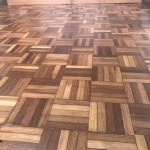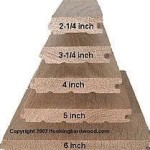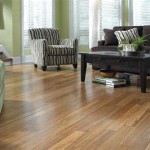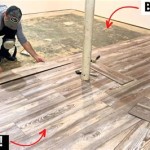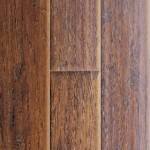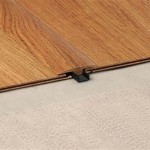Can You Install Laminate Wood Flooring in a Bathroom? A Comprehensive Guide
Laminate wood flooring has gained considerable popularity as a cost-effective and visually appealing alternative to hardwood, stone, or tile. Its ease of installation and diverse design options make it an attractive choice for many homeowners. However, a common question that arises is whether laminate flooring is suitable for bathrooms, a space characterized by high moisture and humidity levels. This article will delve into the suitability of laminate flooring in bathrooms, exploring its pros, cons, installation considerations, and alternative options.
Laminate flooring is a multi-layered synthetic flooring product. The core layer is typically composed of high-density fiberboard (HDF) or medium-density fiberboard (MDF). A decorative layer, often a photographic image of wood, stone, or tile, is then applied to the core. This decorative layer is protected by a transparent wear layer, which provides resistance to scratches, dents, and fading. Finally, some laminate flooring products may feature an attached underlayment for added sound insulation and cushioning.
The primary concern when considering laminate flooring for a bathroom is its susceptibility to water damage. The HDF or MDF core is highly absorbent, and prolonged exposure to moisture can cause it to swell, warp, and delaminate. This can lead to unsightly damage, structural instability, and potentially costly repairs. While some laminate flooring products are marketed as water-resistant or waterproof, it’s crucial to understand the limitations of these claims and the specific requirements for bathroom installations.
Understanding Water Resistance vs. Waterproofing
It is important to differentiate between water-resistant and waterproof laminate flooring. Water-resistant laminate flooring is designed to withstand spills and splashes for a limited period. The wear layer and surface treatments provide a degree of protection against surface water penetration. However, if water seeps through the seams between planks or penetrates from below, it can still damage the core layer. Water-resistant laminate is generally suitable for areas with occasional spills but is not recommended for areas with consistent moisture exposure.
Waterproof laminate flooring, on the other hand, is engineered to completely prevent water from penetrating the core. These products typically feature a core made of waterproof materials, such as polymer composites or specialized HDF treated with water-repellent chemicals. The seams between planks are often sealed with a tight-locking mechanism and may even incorporate a waterproof sealant. While waterproof laminate offers superior protection against water damage, it is still important to address potential sources of excessive moisture in the bathroom.
Even with waterproof laminate, preventative measures are essential. These include prompt cleanup of spills, proper ventilation to reduce humidity, and ensuring that plumbing fixtures are properly sealed to prevent leaks. Consider the location of the flooring. Areas directly exposed to shower spray or frequent splashing present a higher risk of water damage, even with waterproof options.
Factors to Consider Before Installing Laminate in a Bathroom
Several factors should be carefully considered before making a decision about installing laminate flooring in a bathroom. These include the bathroom's ventilation, the type of laminate flooring, the quality of installation, and the potential for water exposure.
Ventilation: Proper ventilation is crucial for minimizing humidity levels in the bathroom. A well-functioning exhaust fan can remove excess moisture generated during showers and baths, reducing the risk of water damage to the laminate flooring. Insufficient ventilation can lead to condensation and prolonged moisture exposure, even with water-resistant or waterproof laminate.
Type of Laminate Flooring: Choosing the right type of laminate flooring is paramount. If laminate is the chosen material, opting for a product specifically labeled as waterproof is highly recommended. Carefully review the manufacturer's specifications and warranty information to ensure that the flooring is suitable for bathroom applications. Look for features such as a waterproof core, tight-locking seams, and a durable wear layer.
Quality of Installation: Proper installation is essential for preventing water damage. The subfloor must be level, clean, and dry before installation. Any imperfections in the subfloor can create gaps between the laminate planks, allowing water to seep through. Seams should be tightly fitted, and a waterproof sealant should be applied along the perimeter of the room and around plumbing fixtures to prevent water penetration. A professional installation is generally recommended to ensure that the flooring is properly sealed and protected.
Potential for Water Exposure: The level of water exposure in the bathroom should be assessed. Bathrooms with frequently used showers or bathtubs are more susceptible to water damage. Consider the location of the flooring in relation to these water sources. Areas directly exposed to shower spray or frequent splashing present a higher risk, even with waterproof laminate. In such cases, alternative flooring options with superior water resistance, such as tile or vinyl, may be more suitable.
Furthermore, consider the underlayment. While some laminate floors come with pre-attached underlayment, in bathroom settings, it is advisable to use a separate, waterproof underlayment. This provides an additional barrier against moisture rising from the subfloor and helps prevent mold and mildew growth.
Installation Best Practices for Bathrooms
If the decision is made to install laminate flooring in a bathroom, following best practices during installation is crucial to maximize its lifespan and minimize the risk of water damage.
Subfloor Preparation: Ensure that the subfloor is level, clean, and dry. Any imperfections should be addressed before installation. Use a self-leveling compound to correct unevenness and repair any cracks or holes. Clean the subfloor thoroughly to remove any dust, debris, or adhesive residue. Allow the subfloor to dry completely before installing the laminate flooring.
Waterproof Underlayment: Install a waterproof underlayment over the subfloor. This provides an additional barrier against moisture and helps prevent mold and mildew growth. Overlap the edges of the underlayment and seal them with waterproof tape to create a continuous moisture barrier.
Sealing the Perimeter: Apply a bead of waterproof sealant along the perimeter of the room where the laminate flooring meets the walls. This prevents water from seeping under the flooring and damaging the core. Also, seal around any pipes or other fixtures that penetrate the flooring.
Proper Ventilation: Ensure that the bathroom has adequate ventilation. Install or upgrade the exhaust fan to effectively remove moisture during and after showers and baths. Encourage occupants to use the exhaust fan regularly to minimize humidity levels.
Regular Maintenance: Implement a regular maintenance routine to keep the laminate flooring clean and dry. Wipe up spills promptly and avoid using excessive water when cleaning. Use a damp mop or cloth with a mild detergent specifically designed for laminate floors. Avoid using abrasive cleaners or harsh chemicals that can damage the wear layer.
Monitor for Leaks: Regularly inspect plumbing fixtures for leaks and address them promptly. Leaking faucets, toilets, or showerheads can introduce excessive moisture into the bathroom and damage the laminate flooring. Ensure that all plumbing connections are properly sealed.
Another important aspect of installation is allowing the laminate flooring to acclimate to the bathroom's environment before installation. This involves storing the flooring in the bathroom for several days prior to installation to allow it to adjust to the temperature and humidity levels. This reduces the risk of expansion and contraction after installation, which can lead to gaps and warping.
Even with meticulous installation and maintenance, laminate flooring in a bathroom is not without its risks. Consider the long-term implications and potential for future water damage before making a final decision.
Alternative flooring options that offer superior water resistance and durability in bathroom settings include:
- Ceramic or Porcelain Tile: Tile is highly resistant to water damage and is a popular choice for bathrooms. It is available in a wide range of styles, colors, and sizes.
- Vinyl Flooring: Vinyl flooring, particularly luxury vinyl planks (LVP) and luxury vinyl tiles (LVT), offers excellent water resistance and durability. It is also relatively easy to install and maintain.
- Stone Flooring: Natural stone flooring, such as granite or slate, is another durable and water-resistant option for bathrooms. However, stone flooring can be more expensive than other alternatives.
Ultimately, the decision of whether to install laminate flooring in a bathroom depends on individual preferences, budget constraints, and the specific characteristics of the bathroom environment. Carefully weigh the pros and cons, consider the potential risks, and explore alternative flooring options before making a final decision. Proper installation, regular maintenance, and diligent attention to potential water issues are essential for maximizing the lifespan and minimizing the risk of damage if laminate flooring is chosen.

How To Install Waterproof Laminate Flooring Twenty Oak

Does Laminate Make The Best Bathroom Flooring Carpet Guys

Choosing Laminate Flooring For Your Bathroom Tarkett

Know The Benefits Of Laminate Flooring In Bathroom

How To Install Vinyl Plank Flooring In A Bathroom Fixthisbuildthat

Waterproof Laminate Flooring Review Pros And Cons

The Pros Cons Of Bathroom Flooring Options Carpet Court

Know The Benefits Of Laminate Flooring In Bathroom

Bathroom Flooring What Are Your Options Direct Wood

Can You Install Laminate Flooring In Bathrooms Canadia
Related Posts



